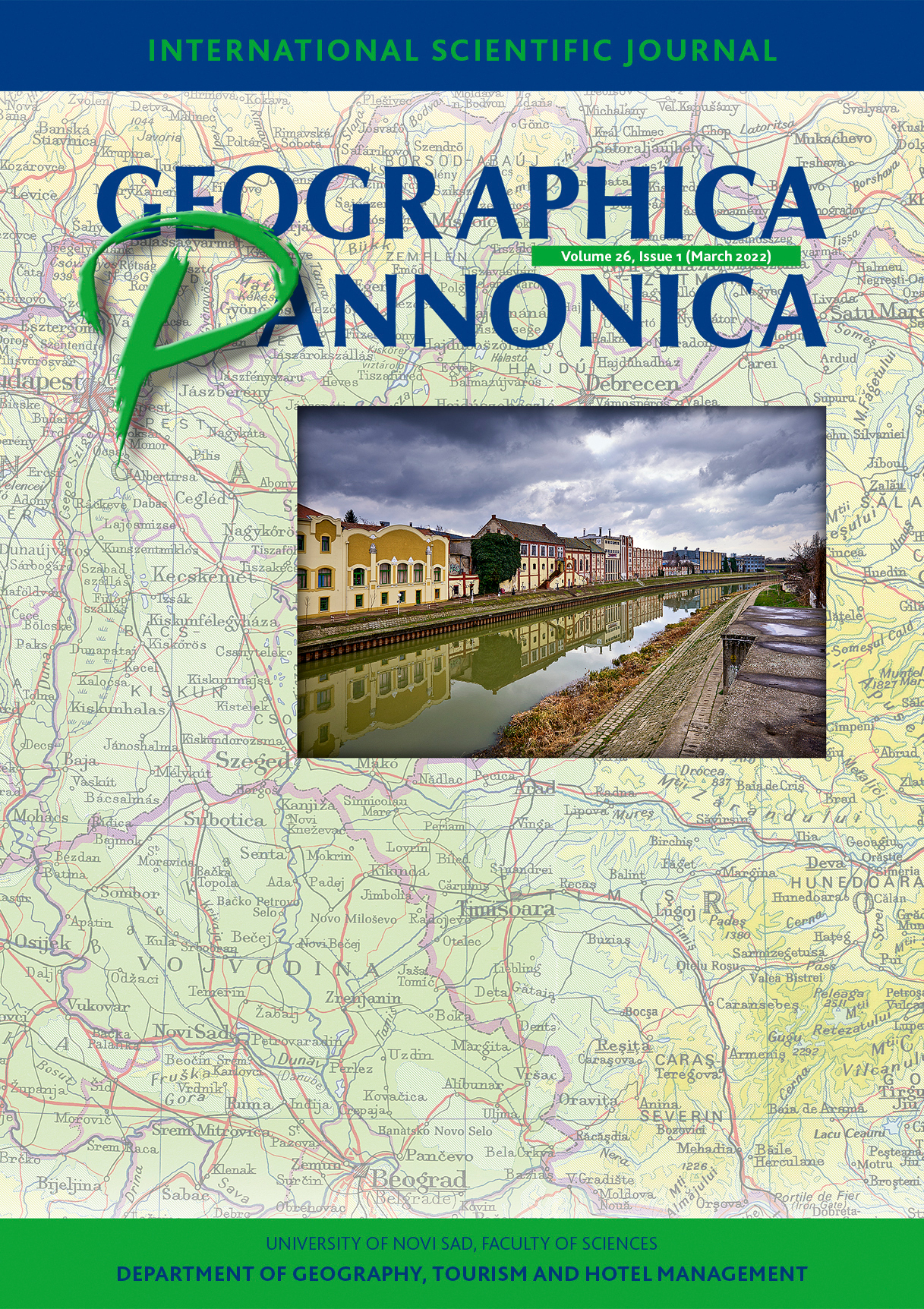Using Geostatistics to Generate a Geological Model of a Sandstone Petroleum Reservoir in Southern California
Abstract
A variogram-based two-point geostatistical approach was applied to generate a geological model of a petroleum reservoir. The geology consists of a sandstone formation with uniformly inclined rock strata of equal dip angle structurally trapped by surrounding faults. Data exploration of electrical well logs using univariate/bivariate statistical tests and data transformation tools demonstrated the data to be statistically suitable for ordinary kriging and sequential Gaussian simulation. Three directions were defined as part of the variogram and the data were interpolated resulting in a 3D subsurface representation. Validation included performing a leave-one-out cross-validation for each well and statistical comparison of multiple realizations generated from a computed stochastic model. The results display a reliable geological model which indicate a direct causation of the continuity trends from the bedding attitude of the regional fault trap.
References
Babish, G. (2000). Geostatistics Without Tears: A Practical Guide to Geostatistics, Variograms and Kriging. Regina, Sask: Environment Canada, Ecological Research Division, Environmental Conservation Branch.
Caers, J., & Zhang, T. (2004). Multiple-Point Geostatistics: A Quantitative Vehicle for Integrating Geologic Analogs into Multiple Reservoir Models. Stanford, Calif: American Association of Petroleum Geologists. https://doi.org/10.1306/M80924C18
Caumon, G., (2010). Towards Stochastic Time-Varying Geological Modeling. Mathematical Geosciences, 42(5), 555-569. https://doi.org/10.1007/s11004-010-9280-y
Deutsch, C.V. (2006). What in the reservoir is geostatistics good for? Journal of Canadian Petroleum Technology, 45(4). https://doi.org/10.2118/06-04-DAS
Dorsey, R. (1993). Geologic Review Abacherli Lease Mahala Field: Eastern Puente Hills San Bernardino, California. KMT Oil Company
Dubrule, O., & Damsleth, E. (2001). Achievements and Challenges in Petroleum Geostatistics. Petroleum Geoscience, 7(S), S1-S7. http://dx.doi.org/10.1144/petgeo.7.S.S1
Ebong, E., Akpan, A., Ekwok, S., Esu, E., & Ebong, L. (2021). 3-D reservoir characterization and hydrocarbon volumetric estimation of parts of Niger Delta Basin-Nigeria. Journal of African Earth Sciences, 180, 104207. https://doi.org/10.1016/j.jafrearsci.2021.104207
Elfadil, M., Al-Yaqout, A., & Hefny, A. (2018). Volumetric soil profile modeling using geo-statistics and GIS: case study Kuwait Sabkha. Arabian Journal of Geosciences, 11(7). https://doi.org/10.1007/s12517-018-3474-x
Gorell, S. (1995). Using geostatistics to aid in reservoir characterization. The Leading Edge, 14(9), 967-974. http://dx.doi.org/10.1190/1.1437188
Gringarten, E., & Deutsch, C.V. (1999). Methodology for Variogram Interpretation and Modeling for Improved Reservoir Characterization. Society of Petroleum Engineers Annual Technical Conference and Exhibition. Houston, Texas. https://doi.org/10.2118/56654-MS
Journel, A.G. (2000). Geostatistics and Petroleum Geology. Mathematical Geology, 32(1), 139-141. https://doi.org/10.1023/A:1007563003567
Kaur, L. & Rishi, M., (2018). Integrated geospatial, geostatistical, and remote-sensing approach to estimate groundwater level in North-western India. Environmental Earth Sciences, 77(23). https://doi.org/10.1007/s12665-018-7971-8
Kelkar, M., & Perez, G., (2002). Applied geostatistics for reservoir characterization. Richardson, Tex: Society of Petroleum Engineers.
Kim, M., Kim, H., & Chung, C., (2020). A Three-Dimensional Geotechnical Spatial Modeling Method for Borehole Dataset Using Optimization of Geostatistical Approaches. KSCE Journal of Civil Engineering, 24(3), 778-793. https://doi.org/10.1007/s12205-020-1379-1
Madden, C., & Yeats R. (2008). Paleoseismic and Structural Investigations to Determine Late Quaternary Slip Rate for the Chino Fault, Southeastern Los Angeles Basin, California. United States Geological Survey: 04HQGR0107
Masaud, M., & Meddaugh, W.S. (2019). Reservoir Characterization-Geostatistical Modeling of the Paleocene Zelten Carbonate Reservoir. Case Study: Meghil Field, Sirte Basin, Lybia. Society of Petroleum Engineers Annual Technical Conference and Exhibition. Calgary, Alberta. https://doi.org/10.2118/195988-MS
Nobre, M., & Sykes, J., (1992). Application of Bayesian Kriging to subsurface characterization. Canadian Geotechnical Journal, 29(4), 589-598. https://doi.org/10.1139/t92-066
Olea, R., Charpentier, R., Cook, T., Houseknecht, D., & Garrity, C. (2012). Geostatistical Population-Mixture Approach to Unconventional-Resource Assessment with an Application to the Woodford Gas Shale, Arkoma Basin, Eastern Oklahoma. SPE Reservoir Evaluation & Engineering, 15(05), 554-562. https://doi.org/10.2118/163049-PA
Olson, L. (1977). Mahala oil field and vicinity. Sacramento: California Division of Oil & Gas.: TR18.
PetroWiki (2016). Geostatistical conditional simulation - PetroWiki. [online] Available at: <https://petrowiki.spe.org/Geostatistical_conditional_simulation> [Accessed 20 July 2021].
PetroWiki (2020). Kriging and cokriging - PetroWiki. [online] Available at: <https://petrowiki.spe.org/Kriging_and_cokriging> [Accessed 20 July 2021].
Sabouhi, M., Azad, M.N., & Rezaee, P. (2019). Geostatistical Lithofacies Modeling of Carbonate-Evaporite Succession-Kangan Formation-Based on Variography Analysis and Sequential Indicator Simulation Method in One of the Hydrocarbon Fields of Persian Gulf. Petroleum Research, 29(108), 42-45. DOI: 10.22078/pr.2019.3630.2655
SatishKumar, K., & Rathnam, E.V. (2020). Regional Optimization of Existing Groundwater Network Using Geostatistical Technique. Numerical Optimization in Engineering and Sciences, 979, 93-106. https://doi.org/10.1007/978-981-15-3215-3_10
Uyan, M., & Dursun, A. (2021). Determination and modeling of lignite reserve using geostatistical analysis and GIS. Arabian Journal of Geosciences, 14(4). https://doi.org/10.1007/s12517-021-06633-2
Yerkes, R., McCulloh, T., Schoellhamer, J., & Vedder, J. (1971). Geology of the Los Angeles Basin, California- an Introduction. Washington: U.S. G.P.O.: 420-A

